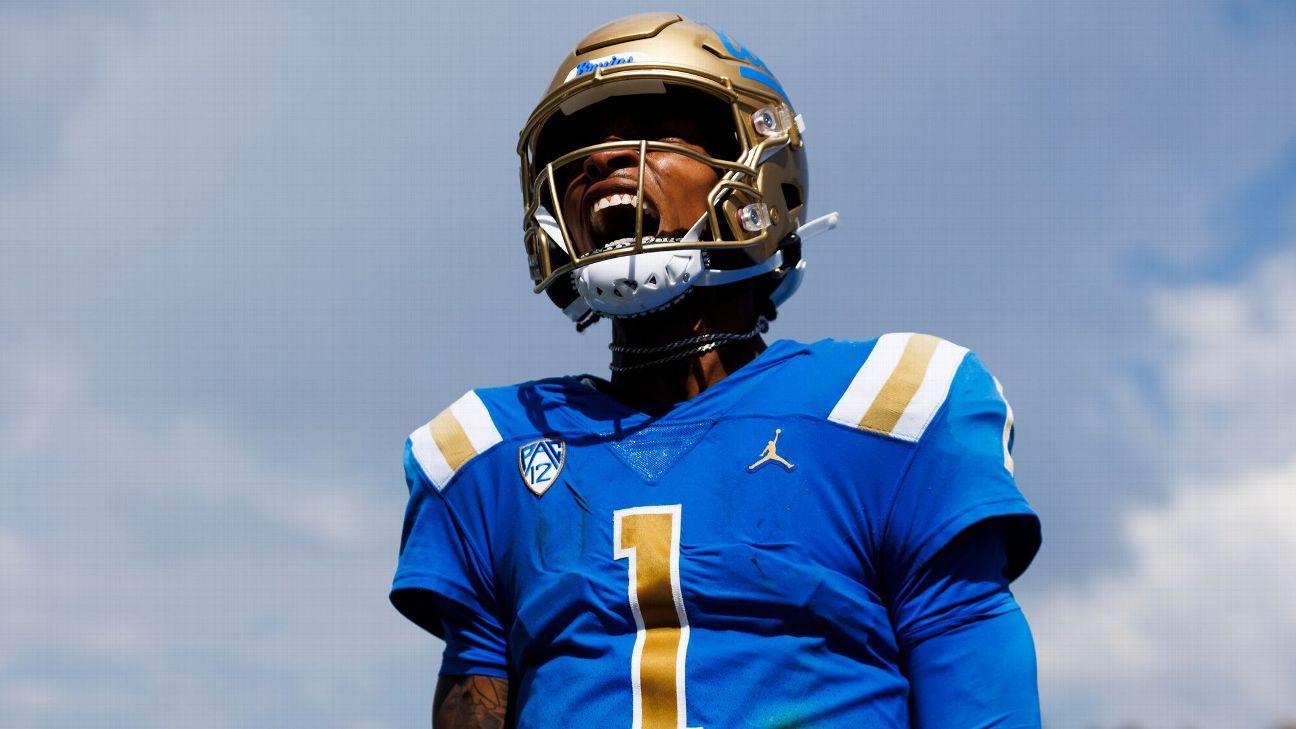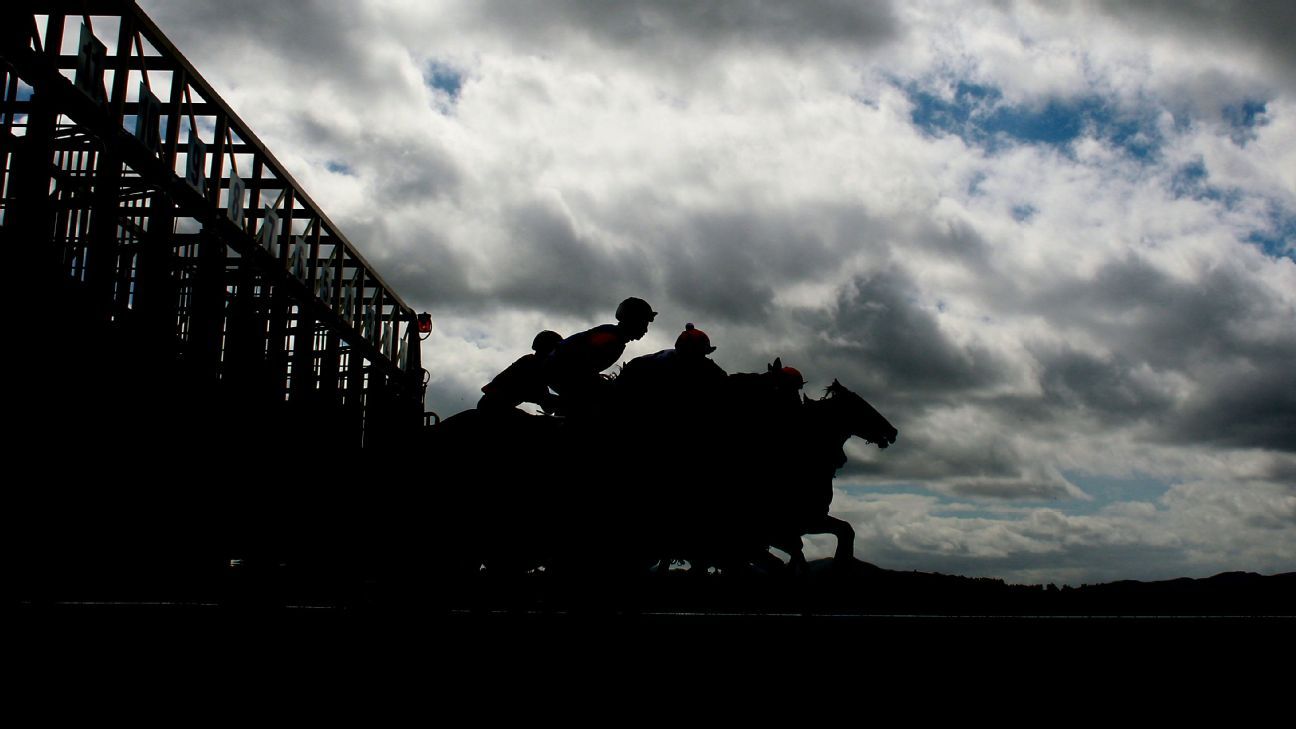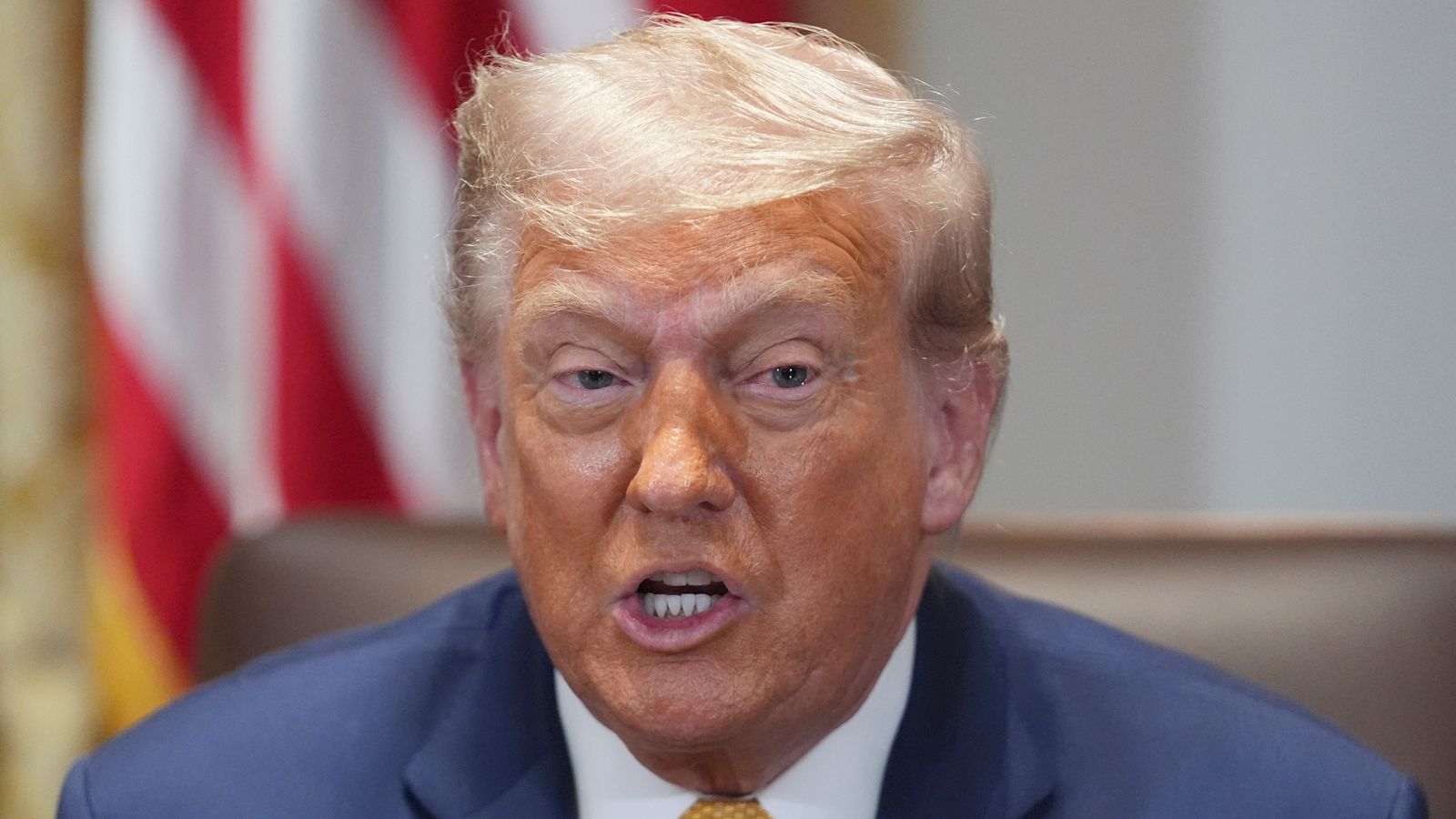
LOS ANGELES — The Rose Bowl press box was shaking. UCLA quarterback Dorian Thompson-Robinson had found wide receiver Logan Loya on a crossing route across the middle and the receiver had turned it into a 70-yard touchdown. The score put the Bruins up 10 points on No. 11 Utah and sent the crowd on hand — most of the season-high 42,038 sitting in the shaded side of the stadium — into a frenzy.
If it took a second for those inside the box to notice the movement, it’s because the Rose Bowl press box hasn’t moved much, if at all, this season. After two games with fewer than 35,000 fans in attendance, the Bruins’ 4-0 start had more people gawking at half-empty stadium pictures online than witnesses on hand.
But the sport’s most storied venue got more crowded when UCLA upset Washington on Sept. 30 to earn a No. 18 ranking in the polls and a host of national attention. The snowball effect carried over to Saturday’s kickoff against Utah. Before the game, the Rose Bowl sidelines were peppered with a plethora of alumni, former players, boosters and guests that had shown up to watch the Bruins warm up and eventually move to 6-0.
“The energy and excitement around this team is palpable,” UCLA athletic director Martin Jarmond told ESPN. “Best ball in the country is being played at the Rose Bowl.”
About 14 miles southwest of the Rose Bowl, a few hours after the Bruins pulled off their second upset in two weeks, USC athletic director Mike Bohn and USC president Carol Folt stood at the south end zone of the Los Angeles Coliseum and continued what has become tradition: greeting players and coaches after wins. On Saturday night, a lei-wearing Lincoln Riley shook hands with Bohn and Folt before greeting recruits as he walked off the field 6-0 as USC head coach after beating Washington State. The program hasn’t been 6-0 since 2006 — or as people around these parts more commonly know it, the Pete Carroll days.
“I think it’s really positive,” Bohn told ESPN of the two schools being undefeated. “This is what makes L.A. sports great.”
Saturday marked a unique day in the city: Over the course of eight hours, across multiple L.A. freeways filled with traffic, UCLA proved it belonged in the upper echelon of college football, while USC continued to display traits of an elite team. The last time both teams were undefeated through the first six games was 2005. A lot has changed since — at each program, in the city (there are two NFL teams now!) — but after a handful of down years for college football in L.A., things are looking up on both sides of town.
“To succeed in L.A., you not only need to win,” said Jeff Fellenzer, a professor of sports, business and media at USC who grew up in a UCLA household. “You need to win and be entertaining when you win, and you need to have star power, and [both teams] are checking all those boxes.”
ON THE CONCOURSE level of the stadium, just below the Rose Bowl boxes and suites that were filled Saturday, UCLA has a plaque labeling its biggest donors. In the “$100,000 or more” category, one name stands out above the rest: Troy Aikman.
The former Bruin and NFL Hall of Famer called UCLA’s attendance issues “an embarrassment” just a few weeks ago but said those issues even plagued his UCLA team when it was No. 1 in the nation. Aikman called for a smaller, on-campus stadium, but if you’ve ever been to Westwood — or the west side of L.A. for that matter — you know that’s probably not happening any time soon.
Attendance has been a running theme for the Bruins, whose campus is 30 miles across the city from the Rose Bowl. The recent L.A. heat wave and lackluster opponents meant the first three games’ attendance didn’t reach 40,000, with the opening game against Bowling Green featuring only 27,143. Tarps covering large sections of the stadium have remained even through this week. As coach Chip Kelly pointed out recently, the Bruins also have to deal with the fact that the UC school system is on quarters, not semesters, which means students don’t arrive on campus until about Week 3 of the season.
“It would be like holding a home football game at USC in late July. I mean, it seems silly,” Fellenzer said. “That’s a real factor.”
Fellenzer, who has missed only one (non-pandemic season) UCLA-USC game in person since 1964, was in the press box earlier this season when UCLA faced South Alabama and recalled seeing virtually no student section because school was not in session. He has since returned as a fan against Washington and Utah.
“There was more energy,” Fellenzer said of the game against Utah. “There was a feeling that maybe something special was around the corner.”
Indeed, the vibe among fans at the Rose Bowl on Saturday was that of anticipation. If this Bruins team was going to keep beating teams the rest of the country said were better, they wanted to be there to witness it.
UCLA, for its part, has also tried to make the game experience better for fans so that attendance isn’t solely based on results. Against Washington, it featured fireworks pregame, a halftime fireworks show and lights coordinated to music as well as an in-game MC. The latter is something USC has also had the past few years. Whether those entertainment features are bringing more fans to the stadium is hard to gauge, but the point seems to be to enhance the experience for those who do show up.
Percentage-wise, attendance has been better at USC (averaging just below 80% capacity on home games this season), due in large part to the renewed sense of direction from hiring Riley and bringing in transfers Caleb Williams and Jordan Addison. Players who have been in the program the past few seasons say they have noticed a difference.
“Tonight was electric,” said senior offensive lineman Andrew Vorhees after Saturday’s game, which featured more than 63,000 fans.
Vorhees remembers the 2017 game against Texas when the Coliseum was almost sold out. He’s hoping that if the Trojans keep playing like this, they’ll get close to another sellout this season.
Winning remains king, and with USC and UCLA facing tough road matchups at Utah (Oct. 15) and Oregon (Oct. 22), respectively, away game results might be what set the tone for the home atmosphere the rest of the season. For now, though, the winning has both those in blue and cardinal wearing rose-colored glasses.
After Friday night’s win, one UCLA official was heard yelling through the hallways, “What are they going to say now?” And on Saturday, even Aikman logged back on Twitter to send a congratulatory message to Kelly’s team and give credence to the slow-brewing Heisman hype building around Thompson-Robinson.
Great win today for Chip Kelly and the 6-0 UCLA Bruins in the biggest test of the season and @doriansTweets put himself in the Heisman Trophy conversation w another outstanding performance🙌🏼 @UCLAFootball @UCLAAthletics
— Troy Aikman (@TroyAikman) October 9, 2022
“UCLA wins that game, then the sky’s the limit in what you could shoot for this season,” Fellenzer said. “I think that was that feeling in the air, even though it was also a hotter day than I think any of us expected. Everybody was sort of willing to endure that because now there was something to really get excited about.”
COLLEGE FOOTBALL IN modern-day Los Angeles is a vexing proposition. Though both UCLA and USC have fervent fan bases and alumni groups, there’s no centralized hub around either program because of the sprawling nature of the city. USC comes close, with its campus walking distance to the Coliseum, but the proximity to downtown both means there’s plenty of other things around and any fan coming to the game is likely making a serious commute.
Insert the obligatory L.A. traffic comment here.
Sometimes in L.A., though, even winning might not be enough. The way in which that winning is done and with whom, matters, too. It’s cliché, but the city loves its stars.
“I think a big part of it is having these two electric quarterbacks who are worth the price of admission,” Fellenzer said. “It reminds me a bit of those Aikman-[Rodney] Peete matchups in 1987 when you had major star power at quarterback.”
Football, as an entertainment product, has always been about the quarterback first. And both USC and UCLA this season have potential Heisman Trophy contenders in Williams and Thompson-Robinson. So far this season, the two have had their share of highlights and performances, which has been the programs’ most effective form of advertising. Because of the city’s size, transient population and multiple teams for every major sport, there’s no single unifying team. The Dodgers and Lakers are the teams that come closest to turning sports in L.A. into a monoculture. USC and UCLA’s appeal, though, lies at the heart of that very split. Their rivalry is the city’s best. Yet it’s also at its best only when the two teams are playing well. Recently, that hasn’t been the case. With both the Trojans and Bruins struggling on the field the past few seasons, there has been no reason, as far as L.A. sports fans are concerned, to make the trek to downtown or Pasadena.
Riley hasn’t shied away from accepting the reality of being a sports team in L.A., alluding to the fact that he knows the crowds will come if they keep winning.
“We understand that in this city, and I think it’s fair, we gotta go prove who we are as a team,” Riley said after the season opener. “We’re going to do everything we can as a team to keep working so that people can’t even stand the thought of not coming to a USC football game.”
In the span of a few weeks, winning has changed the tone, or at the very least, given the matchup between the two teams in mid-November with a lot more juice. As soon as both teams won Saturday, many, including Fellenzer, scanned the remaining schedule for each team to see what the possibility of both teams going undefeated into that game could be.
Fellenzer was quick to point out, though, that if the two remain undefeated heading into this year’s installment of The Game, it might still not top the 1967 game. That season, UCLA was No. 1 in the country, USC was No. 4, and both teams boasted Heisman candidates — RB O.J. Simpson for USC, QB Gary Beban for UCLA. That game also decided the Pac-8 champion, the Rose Bowl participant and the national champion. The Trojans went on to win the game 21-20, but Beban went on to win the Heisman.
Of course, because of the Pac-12’s new rules this season, there is a chance that UCLA and USC face each other twice — once in their normal regular-season matchup (this year’s will be at the Rose Bowl) and then potentially on Dec. 3 in Las Vegas — Thompson-Robinson’s hometown — with the Pac-12 championship on the line.
“Even if one of them loses, I still think it will be a massive game this year,” Fellenzer said. “I don’t know how many tickets would be available for the Rose Bowl, but I think you would get a huge crowd.”
AFTER THE CLOCK hit zero at The Rose Bowl on Saturday, UCLA fans stayed. They crowded the stands near the tunnels, gave ovations to Kelly and Thompson-Robinson — the former was uncharacteristically happy postgame, inviting more questions even after he was supposed to be done — and basked in the glory of success that felt overdue.
As the rest of the team and Utah trickled into the stadium tunnel, one UCLA fan stayed back and made sure to get the visiting team’s attention. He wasn’t thinking about the bye week. Or about playing No. 12 Oregon in Eugene after that.
“Hey Utah!” he called out to the remaining players and fans. “You go beat SC next week! Beat SC!”
Much like at USC, where the band plays “Tusk,” which features the “UCLA sucks” chants at the end of every victory, the two rivals never seem to be far away from each other’s thoughts. Should they both keep winning, that sentiment will only continue to heighten and from downtown to the eastside, the crowds should continue to get louder, too.












